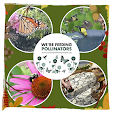This Blog is no longer receiving active posts due to a family loss which lead to the forced sale of the Pollinator Potager's location.
I am pleased to relate that the garden is still being tended by the new property owner, for which I am grateful.
The memories of my Pollinator Potager Project will remain here, and in my heart.
 |
Cicada exoskeleton left behind
on Stella Peach Hemerocallis |
It's summer, and we've been listening to the mesmerizing buzz of the somewhat elusive Cicada. It's a nostalgic sound I remember all the way back to my early childhood: A noise always expected during the very hottest days of summer.
Ironically, sightings of actual cicadas didn't always produce a warm and fuzzy feeling, for me at least. I thought them more than a little creepy, having once found a cicada exoskeleton - almost as big as my child-sized hand - clinging to the Willow tree trunk in our yard.
Lately, though, hubby and I have become mesmerized by not just the mystic sound of the cicada; but, also the life cycle and habits of the ancient Cicadidae.
For instance, we've learned that local cicadas typically make their homes in trees. They are sustained by tree sap and lay their eggs in cracks in the tree bark: Our Little Leaf Linden tree with its deep cracks and crevices must be a great draw, explaining the frequency of sightings in our garden.
The larva that fall to the ground and burrow below the soil at the base of the tree, eventually emerge and leave their exoskeleton behind in various locations. Cicadas that live in our neck of the woods are generally considered an annual species; and, their distinctive humming sound is actually the male cicada's mating call, a sound loud enough to actually cause permanent hearing loss if produced close to a human ear.
I recently rescued a couple of cicada, found early in the morning, lying on their backs with legs flailing. Hubby and I introduced our young grand-daughter to these interesting insects and she was excited to see and learn about both versions of cicada: Winged insect and empty exoskeleton.
It's comforting to know that she won't have the uneasy relationship with cicadas that I had growing up: She even named one, "Cicadie".
 |
| Cicadie, as named by my grand-daughter |
 |
Our Shasta Daisies
passing the baton to
the Black-Eyed Susans
in a relay of blooms |
I love Shasta Daisies! But, I don't love the Shasta's all-too-short bloom-time. For weeks they tease their arrival, only to bloom for as little as 7-days. It's a lot of dragging-of-feet for very little kick-at-the-can.
And, just as I've had to enjoy my daisies on the fly, my Black-Eyed Susan clusters require patience of another kind. These showy favourites typically last longer than daisies; but, it’s usually mid-July before I get to see any blooms at all.
This year, I planted my Black-eyed Susan and Shasta Daisy perennials together – side by side – almost as one plant: A strategy long-known as companion planting. Lucky for me, Daisies and Susans mingle readily, their foliage is complimentary, and their bloom times are virtually consecutive.
The success of this experiment convinced me that the ability to work within the confines of what life has to offer - merging pro and con, yin and yang, Daisy and Susan - is essential in a garden setting; and, just as gardening has always been a series of trade offs and substitutions, a gardener’s occasional creative guidance must work in conjunction with the natural order of things.
Happily, I've learned that just as human runners pass a baton from one team-mate to another in a relay race; similarly, plants pass an invisible baton in a relay of blooms. This year, enjoyment of two of my flowering favourites has been greatly enhanced through creative planting that helped guide one such relay process in my garden to a resounding win.
 |
The Dollar Store Suet turned Fruit Feeder
Enhancing our Garden |
|
|
|
|
|
Last year, I bought a suet feeder from the dollar store, which became lost in the hall closet. I found it again this week; and, realized it could also be filled with fresh fruit for birds and insects to feed upon.
Sliced oranges, melons, berries, apples, etc., are attractive and enticing, as much as they are nutritious to the hungry wildlife visiting our pollinator-friendly garden. A fruit-feeder is also a great vehicle for using up over-ripe fruit, forgotten in the crisper.
This low-cost fruit-feeder certainly looks attractive in my garden; and, as it's serving an important purpose, I’m planning on making it a feature in my garden for at least the remainder of the growing season.




